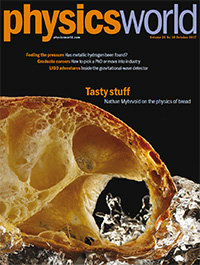 By Matin Durrani
By Matin Durrani
If you’re a student wondering whether to go into research or bag a job in industry, don’t miss our latest Graduate Careers special, which you can read in the October issue of Physics World.
Philip Judge from the US National Center for Atmospheric Research and his colleagues Isabel Lipartito and Robert Casini first describe how budding researchers should pick a PhD to work on. It’s vital as that first project can determine the trajectory of your future career.
But if your eyes are set on a job outside academia, careers guru Crystal Bailey from the American Physical Society runs through your options and calls on academics to learn more about what’s on offer so they can advise their students better.
If you’d rather just stick your head in the sand about your career options, however, then why not enjoy the cover feature of the October issue, in which former Microsoft chief tech officer and Intellectual Ventures boss Nathan Myhrvold discusses his massive new five-volume treatise Modernist Bread.
Mixing history and science – as well as the results of more than 1600 of his own experiments – the book is sure to be the last word on this foodstuff that humans have been baking for millennia.
Don’t miss either Jon Cartwright’s feature on the quest for metallic hydrogen.
Remember that if you’re a member of the Institute of Physics, you can read the whole of Physics World magazine every month via our digital apps for iOS, Android and Web browsers.
For the record, here’s a run-down of what else is in the issue.
• Budget crunch hits Brazilian physics – Brazil’s political crisis is taking its toll on science, with thousands taking to the streets in protest, as Henrique Kugler reports
• A quantum mission – Toshio Hirano, president of Japan’s new National Institutes for Quantum and Radiological Science and Technology, tells Fred Myers how the organization will use its expertise in physics to tackle cancer
• Mobility matters – After recently being denied entry into the UK to attend a science festival, Jessamyn Fairfield warns against limits to the free movement of people
• The scientific sublime – Robert P Crease identifies a physics experiment that philosophers would dub “sublime”
• Show us your metal – One of the rarest metals in the universe, metallic hydrogen could solve many energy problems – but has it finally been isolated in the lab? Jon Cartwright tries to sort out claim from counter-claim
• The physics of bread – Nathan Myhrvold – the polymath physicist whose passions range from cosmology to cooking – is this month publishing a massive, five-volume book about the science of bread and bread-making. Robert P Crease catches up with this intellectual livewire at his Cooking Lab headquarters in Seattle
• The great detector – Tushna Commissariat travels to the forests of Louisiana to visit the LIGO Livingston gravitational-wave observatory, where one of the most sensational discoveries of recent times was made
• Tale of two physicists – Philip Ball reviews The Quantum Labyrinth: How Richard Feynman and John Wheeler Revolutionized Time and Reality by Paul Halpern
• Science at the fringe – Andrew Glester visits this year’s Edinburgh Festival Fringe and seeks out science-themed shows
• Colouring outside the lines – Tushna Commissariat reviews Visions of Numberland: a Colouring Journey Through the Mysteries of Maths by Alex Bellos and Edmund Harriss and Phases of Matter by Colm P Kelleher, Rodrigo E Guerra, Andrew D Hollingsworth and Paul M Chaikin
• Your pathway to industry – Physics graduates must sharpen and tailor their skills for careers in industry, says Crystal Bailey, who also calls on faculty members to provide more
support in this area
• Starting out strong – Philip G Judge, Isabel Lipartito and Roberto Casini share their thoughts for the budding research scientist on how to choose meaningful research
• The measurement problem – David Faux has timing trouble at his local swimming pool
Guidelines
Show/hide formatting guidelines
this text was deletedwhere people live in harmony with nature and animals</q>
Some text